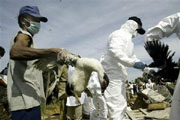VOA标准英语2011--alanced Approach for New Bird Flu Virus Strain
搜索关注在线英语听力室公众号:tingroom,领取免费英语资料大礼包。
(单词翻译)
WHO: Balanced Approach for New Bird Flu Virus Strain
In 2011, scientists discovered they had created a highly contagious1 and deadly form of H5N1 – commonly called avian or bird flu. When the discovery was announced, debate erupted over whether the research was ethical2 and fears the new strain could be used as a bioterrorism weapon. Now, the World Health Organization has weighed in on the issue.
The WHO said it is deeply concerned about the potential consequences of the research that can make H5N1 more contagious among humans. At the same time, it said “studies conducted under appropriate conditions must continue” so critical knowledge can be gained on reducing the risks posed by the virus.
Assistant Director-General Dr. Keiji Fukuda said debate continues to swirl3 even though the findings have not yet been published or reviewed by the WHO.
“They’ve received an extraordinary amount of attention, I think, both in the popular press and the scientific world. A lot of the general issues raised by the papers are reasonably clear. For example, how do you weigh the risks of doing a certain kind of research versus4 the benefits? What are the right procedures and processes that need to be in place? These are fairly fundamental issues for science in general and public health,” he said.
Extra bit of fire
 |
| An Indonesian man helps health officials cull5 poultry6 in the village where a 14-year-old boy died of bird flu Thursday Jan. 11, 2007, on the outskirts7 of Jakarta, Indonesia. (AP Photo/Tatan Syuflana) |
Laboratories in the Netherlands, Japan and the United States developed the new strain of avian flu.
“When you add the fact you’re dealing8 with the H5N1 virus, which is one of the most dangerous viruses around, then it adds that extra bit of fire to the discussion. And so, we’ve been following this and monitoring it pretty closely,” said Fukuda.
Over the years, millions of birds, including poultry, have been killed to prevent the spread of the flu.
“Now there’s a lot of influenza9 viruses which generally infect only birds and this is one of them. But this one stands out because in addition to infecting birds, it also has the ability to infect a wide range of mammals, including humans. Now it does not infect humans very often, but when it does this virus has consistently been about 50 to 60 percent lethal10. So it has an extraordinarily11 high killing12 rate,” he said.
Fukuda described H5N1 as raising the biggest concern about causing a pandemic. He says that’s why the recent research has raised so much attention.
“While this particular situation is focusing a lot of attention on the risks of bioterrorism, dual13 use technology and those kinds of questions, which are important, we also want to make sure that we all take a balanced approach to this. So we have to make sure that research continues. We have to make sure that when research is done the risks to people are as minimum as possible,” he said.
PIP
In May 2011, all World Health Organization member states adopted the Pandemic Influenza Preparedness Framework, or PIP for short. It’s a guide for sharing virus samples and resulting research benefits. In other words, if a virus with the potential for causing a pandemic is found in a poor country, PIP helps ensure that country benefits when a vaccine14 or treatment is developed. That was not always the case in the past. Some developing nations lost out because the vaccines15 or drugs were too expensive.
The WHO assistant director-general said such guidelines should be applied16 to research involving the new H5N1 strain.
“In the overall scheme of things, when you look at public health and how we’re hopefully better at protecting people, making sure that scientific research continues and addresses the critical issues out there (and) fills the gaps in knowledge is absolutely essential. If we don’t have that happen, then we’re always going to be behind the curve and we know that,” he said.
In the meantime, Fukuda said the natural forms of H5N1 continue to be found in a number of countries, such as Egypt and Indonesia. The new form of the virus is currently under the control of the researchers in a few laboratories. One scientist, who helped develop the new strain, says if H5N1 can be made more transmissible in the lab, it can also happen in nature.
 收听单词发音
收听单词发音 




